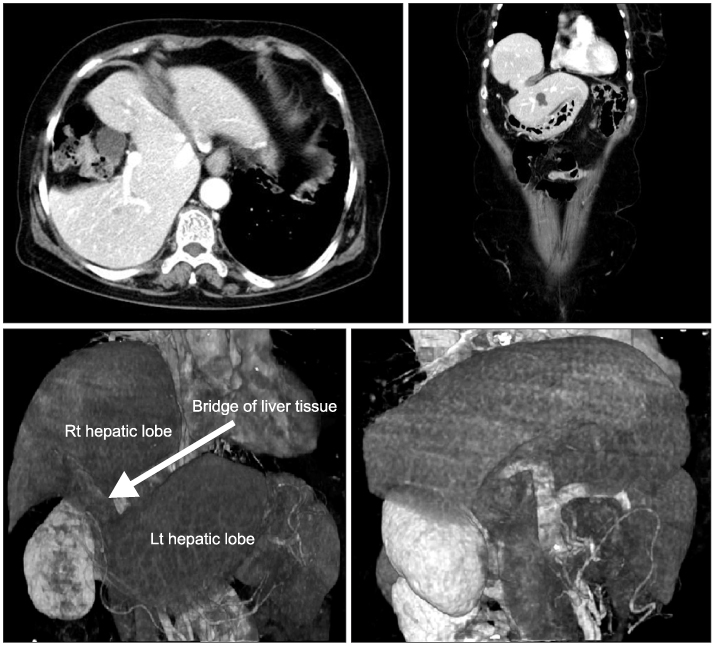Tuberc Respir Dis.
2010 May;68(5):298-300.
Diaphragmatic Hernia of the Right Hepatic Lobe Mistaken for Diaphragmatic Paralysis in Adult
- Affiliations
-
- 1Department of Internal Medicine, Namyangju Hanyang Hospital, Namyangju, Korea. parkaiver@hanmail.net
- 2Department of Internal Medicine, Wonkwang University College of Medicine, Iksan, Korea.
Abstract
- Diaphragmatic paralysis can be demonstrated through diaphragmatic elevation on chest X-ray after thoracic lung surgery or the placement of chest tubing. Additional causes of diaphragmatic paralysis are iatrogenic, mass, atelectasis, etc. For the diagnosis of diaphragmatic paralysis, it required some studies (fluoroscopy, computed tomography [CT], magnetic resonance imaging). Diaphragmatic hernia of the liver is a rare clinical entity, usually found after trauma in adults. Congenital diaphragmatic hernia in neonates requires surgery. Non-traumatic diaphragmatic hernia of the liver in an adult is a rare right-sided diaphragmatic hernia. On developing any symptoms, surgery must be performed. When diaphragmatic hernia is incidentally found in adults without trauma, it is placed under observation for a time period. We diagnosed the diaphragmatic herniation of a right hepatic lobe by 16-slice CT scan without surgery.
MeSH Terms
Figure
Reference
-
1. Ross Russell RI. C 3, 4 and 5, keep the diaphragm alive. Intensive Care Med. 2006. 32:1109–1111.2. Vassilakopoulos T, Petrof BJ. Ventilator-induced diaphragmatic dysfunction. Am J Respir Crit Care Med. 2004. 169:336–341.3. McGuigan R, Azarow KS. Living on the edge: current concepts in the management of congenital diaphragmatic hernia. Curr Surg. 2005. 62:390–395.4. Robertson DJ, Harmon CM, Goldberg S. Right congenital diaphragmatic hernia associated with fusion of the liver and the lung. J Pediatr Surg. 2006. 41:e9–e10.5. Losanoff JE, Sauter ER. Congenital posterolateral diaphragmatic hernia in an adult. Hernia. 2004. 8:83–85.6. Luo HF, Lei T, Wang HJ, Tan G, Wang ZY. Non-traumatic diaphragmatic hernia of the liver in an adult: a case report. Hepatobiliary Pancreat Dis Int. 2007. 6:219–221.7. Daver GB, Bakhshi GD, Patil A, Ellur S, Jain M, Daver NG. Bifid liver in a patient with diaphragmatic hernia. Indian J Gastroenterol. 2005. 24:27–28.8. Zenda T, Kaizaki C, Mori Y, Miyamoto S, Horichi Y, Nakashima A. Adult right-sided Bochdalek hernia facilitated by coexistent hepatic hypoplasia. Abdom Imaging. 2000. 25:394–396.9. Sadeghi N, Nicaise N, DeBacker D, Struyven J, Van Gansbeke D. Right diaphragmatic rupture and hepatic hernia: an indirect sign on computed tomography. Eur Radiol. 1999. 9:972–974.
- Full Text Links
- Actions
-
Cited
- CITED
-
- Close
- Share
- Similar articles
-
- Unilateral Congenital Diaphragmatic Eventration Mimicking Congenital Diaphragmatic Hernia
- Acute Pancreatitis Associated with Diaphragmatic Hernia in an Adult
- Paper-thinned diaphragm: CT sign of diaphragmatic eventration
- Laparoscopic approach in chronic posttraumatic diaphragmatic hernia
- Traumatic Diaphragmatic Hernia with Delayed Presentation in an Adult



